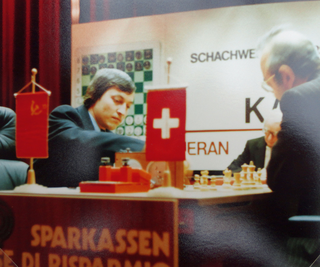The Caro–Kann Defence is a chess opening characterised by the moves:
Petrov's Defence or the Petrov Defence is a chess opening characterised by the following moves:
The Scotch Game, or Scotch Opening, is a chess opening that begins with the moves:
The Nimzowitsch-Larsen Attack is a chess opening typically starting with the move: 1.b3 but sometimes introduced by the move order 1.Nf3 and then 2.b3. The flank opening move 1.b3 prepares to fianchetto the queen's bishop where it will help control the central squares in hypermodern fashion and put pressure on Black's kingside.
The Queen's Gambit Declined is a chess opening in which Black declines a pawn offered by White in the Queen's Gambit:
The Stonewall Attack is a chess opening characterized by White playing pawns to d4 and e3, bishop to d3, knight to d2, and then completing the Stonewall structure by playing pawns to c3 and f4. This set-up is usually achieved by a 1.d4 move order but transposition is also possible via Bird's Opening, 1.f4. The Stonewall Attack is a system; White heads for a very specific pawn formation, rather than trying to memorize long lines of different variations. Black can set up in various ways in response, but MCO-15 gives the following as a main line: 1.d4 d5 2.e3 Nf6 3.Bd3 c5 4.c3 Nc6 5.f4.
Rosendo Carreon Balinas Jr. was a chess grandmaster from the Philippines. FIDE awarded him the International Master title in 1975 and the International Grandmaster title in 1976. He was Philippines' second chess grandmaster. Balinas was a lawyer by profession, as well as an award winning chess writer and journalist. He also unsuccessfully ran for representative of Rizal's 1st district in the 1994 special election.

Lev Osipovich Alburt is a chess Grandmaster, writer and coach. He was born in Orenburg, Russia, and became three-time Ukrainian Champion. After defecting to the United States in 1979, he became three-time U.S. Champion.

The World Chess Championship 1886 was the first official World Chess Championship match contested by Wilhelm Steinitz and Johannes Zukertort. The match took place in the United States from 11 January to 29 March, the first five games being played in New York City, the next four being played in St. Louis and the final eleven in New Orleans. The winner was the first player to achieve ten wins. Wilhelm Steinitz won the match 10–5, winning his tenth game in the twentieth game of the match. There were five draws.

The World Chess Championship 1889 was the second official World Chess Championship, and was between Wilhelm Steinitz and Mikhail Chigorin. It took place in Havana, Cuba. Steinitz defended his world title, and was the first of the two players to reach 10½. He won the match 10½-6½.

A World Chess Championship was played between challenger Max Euwe and title-holder Alexander Alekhine in various cities and towns in the Netherlands from 3 October to 16 December 1935. Euwe was the winner by overcoming a three-point deficit as late as the ninth game.

The 1978 World Chess Championship was played between Anatoly Karpov and Viktor Korchnoi in Baguio, Philippines, from July 18 to October 18, 1978. Karpov won, thereby retaining the title.

The 1981 World Chess Championship was played between Anatoly Karpov and Viktor Korchnoi in Merano, Italy from October 1 to November 19, 1981. Karpov won with six wins against two, with 10 draws. The two players had already played against each other in the World Chess Championship match 1978 in the Philippines, when Karpov also won.
The Nadanian Variation of the Grünfeld Defence is a chess opening characterised by the moves:
The Van 't Kruijs Opening is a chess opening defined by the move:

The World Chess Championship 2018 was a match between the reigning world champion since 2013, Magnus Carlsen, and the challenger Fabiano Caruana to determine the World Chess Champion. The 12-game match, organised by FIDE and its commercial partner Agon, was played at The College in Holborn, London, between 9 and 28 November 2018. The games were broadcast on worldchess.com and by NRK.








